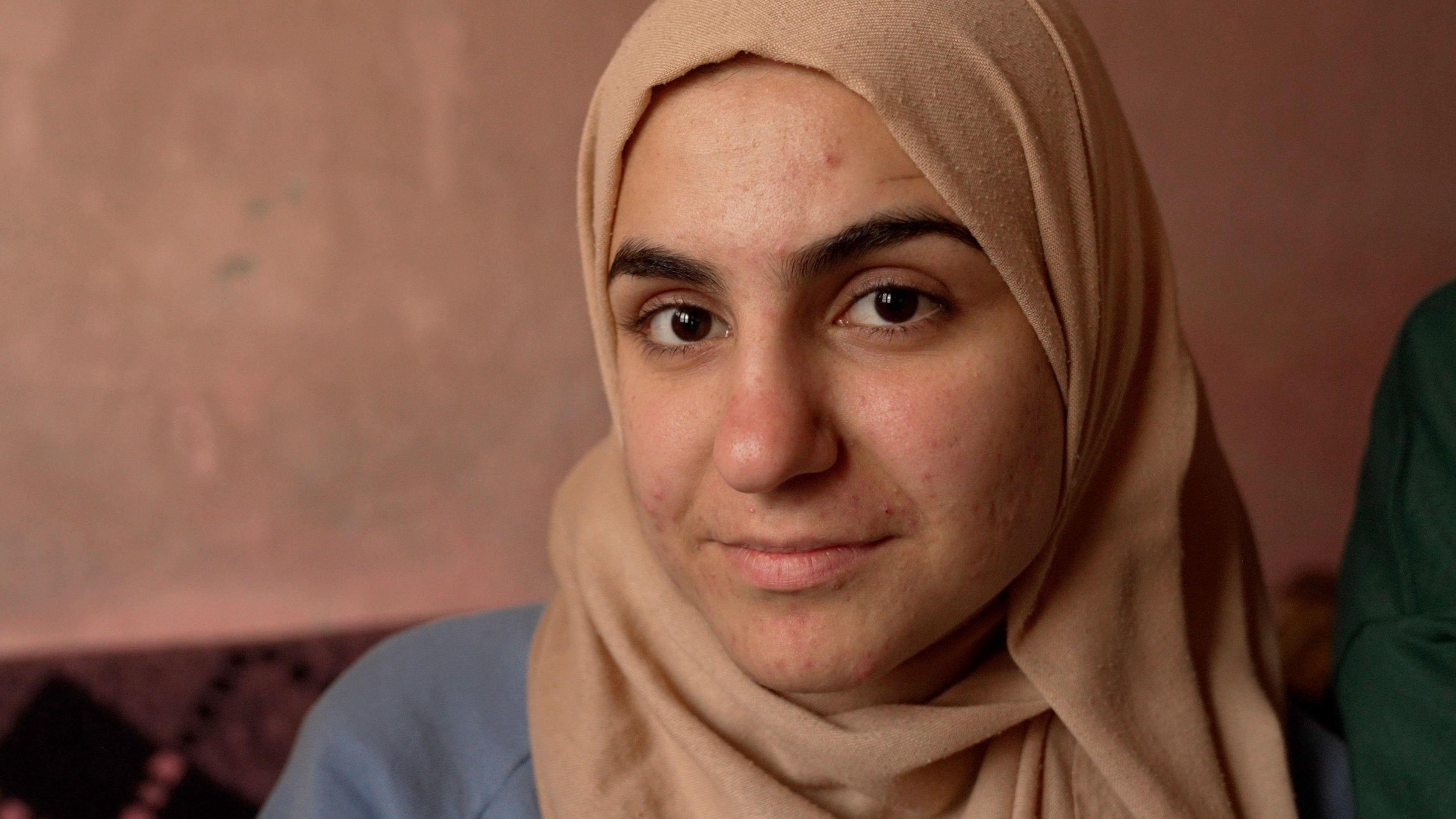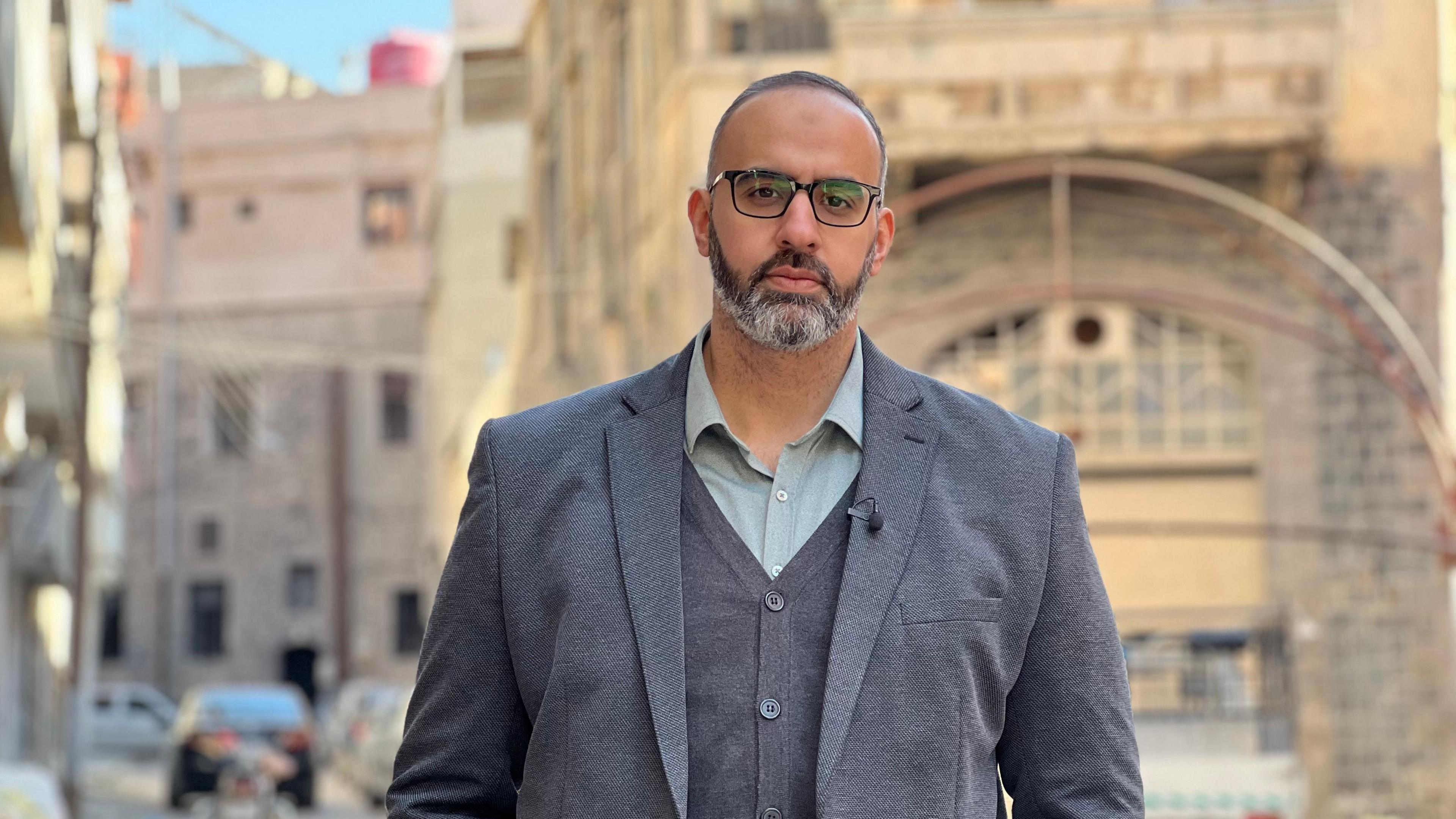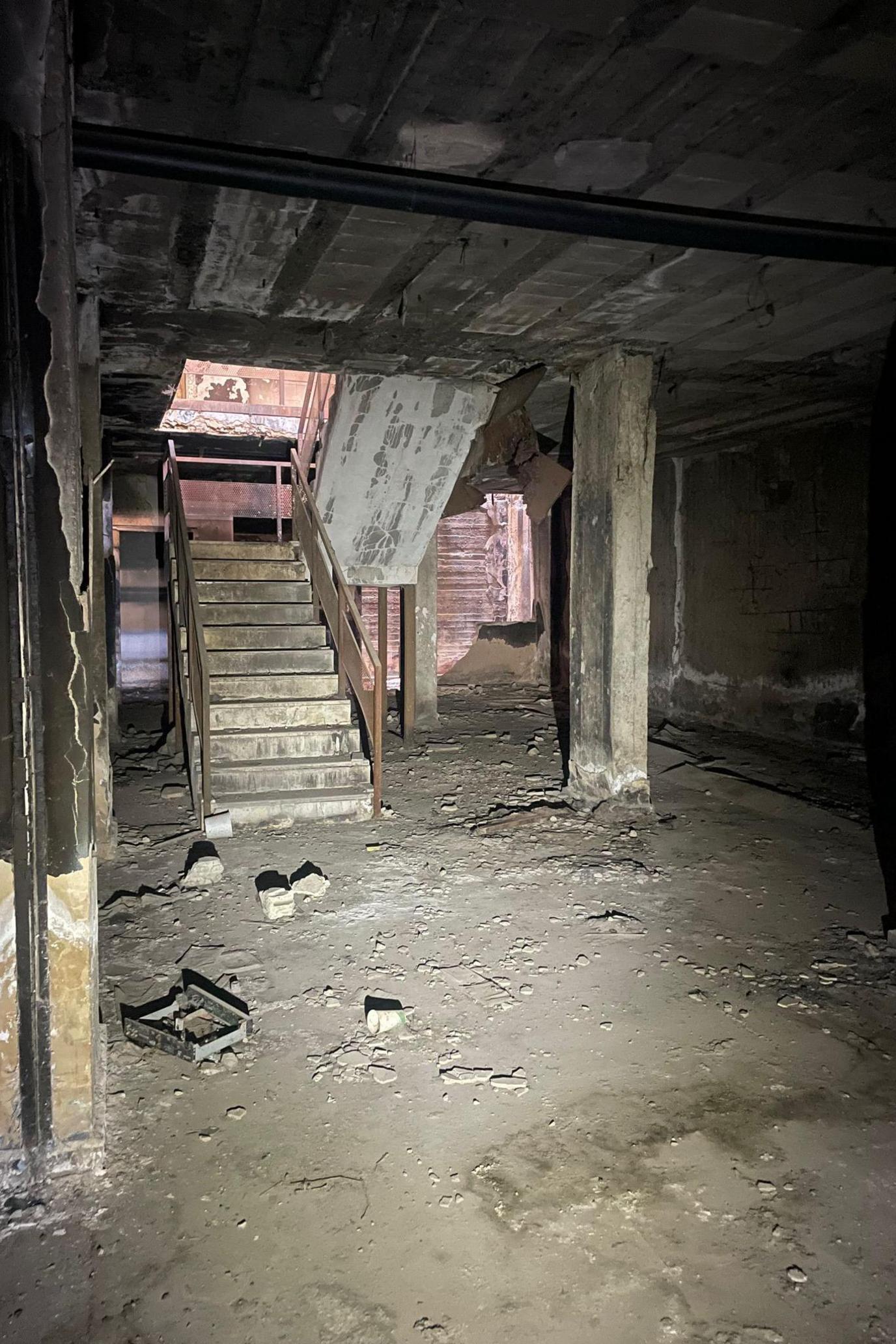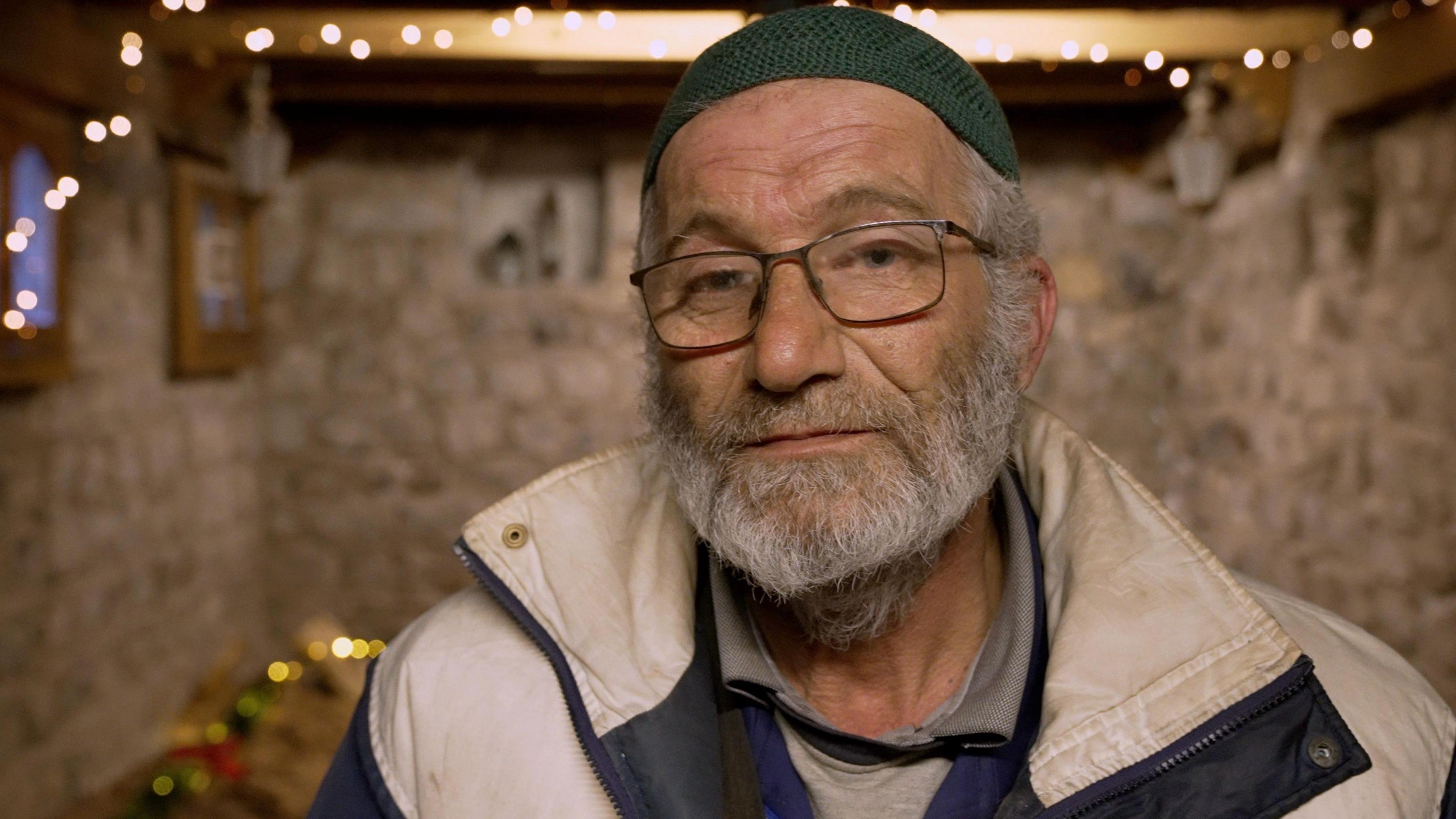Old wounds and new energy in Syria's 'capital of the revolution'

The BBC first interviewed Baraa after she fled the Old City of Homs as a child nearly a decade ago
- Published
"Even now, I look back and wonder how we survived this nightmare," Baraa quietly reflects.
Now 20 years old, the university student joined the joyous celebrations engulfing the streets of Syria last Sunday at the end of Bashar al-Assad's rule.
Her two sisters, Ala and Jana, nod in agreement as we sit, squeezed together on this cold winter's day, on an old lumpy sofa in their humble home in Homs.
Their white-bearded father, Farhan Abdul Ghani, sitting cross legged on the floor, chimes in. "We did not want war. We did not want a forever president who builds monuments to himself."
Nearly a decade ago, we first met in the worst days of that war, waged in their president's name.
Baraa, a deeply traumatised little girl whose eyes darted wildly back and forth, struggled to speak then.
"Sometimes people killed cats to eat," she blurted out as she sat in a disused banquet hall milling with aid officials, Syrian security forces, and distraught families.
For months, many had little to eat except grass pulled from the ground, leaves from the trees, boiled in water with salt and sometimes cinnamon.
"Instead of learning to read and write, I learned about weapons," Baraa told us then so matter-of-factly.

There were scenes of celebrations amid the rubble in Homs after rebel groups took the city last month
Homs was once called the "capital of the revolution" by peaceful protesters who first took to the streets in the spring of 2011 to call for change, before it turned into all-out war.
Baraa and her family were among a thousand civilians rescued from the Old City during a rare UN-supervised humanitarian pause in February 2014.
They somehow survived the agonising two-year-long siege of the old quarter where Syrian troops enforced their first "surrender or starve" cordon in this merciless war.
This medieval torture tactic turned into one of their cruellest weapons, unleashed against one rebel-held stronghold after another.
Months later, more civilians were also given safe passage out of the Old City, as well as the fighters who moved on to continue their fight in other parts of Syria.
The years until this week have been hard on this family and so many others.
"I felt as if I was asleep and I lost hope," Baraa recalls as she adjusts the white headscarf worn by her and her sisters. "We were always afraid of saying the wrong thing, even at the university."
Now, like so many Syrians, she is brimming with palpable joy and optimism in these early heady days of a new start.
"I am dreaming of so many things now, to finish university, to do a master's degree, to improve my English." Her voice trails off as her big goals fill this modest little room.
A frightened little girl whose name means "innocence" had matured into an impressively confident young woman in fashionable blue jeans and a powder blue fleece.
Skulls and body bags: Searching for Syria's disappeared
- Published14 December 2024
Inside Aleppo, the first city to fall to Syrian rebels
- Published12 December 2024
'I want justice': Victims of Syria chemical attacks speak freely for first time
- Published11 December 2024
Her doting father, whose name means happy, beams with pride. He managed to raise his daughters on his own after their mother was slain by a rocket which slammed into their kitchen. It was the children who found her there, slumped over the stove.
His meagre earnings from his fruit and vegetable cart, as well as the kindness of friends, kept them striving for a better life.
"Everything is cheaper now, including food and electricity," he enthuses, in a nod to prices falling in the markets because roads are now open and soldiers at checkpoints are no longer stopping goods or asking for bribes.
It is a blessing for a country where the UN says 90% of Syrians are living beneath the poverty line. "Today I could even afford to buy meat," he gushes.

Dr Hayan al-Abrash struggled to find his underground hospital among the destroyed buildings
Old wounds are still open and painful. Like tens of thousands of other Syrians, he lost a loved one, a brother, in the secret torture cells of Saydnaya prison. When the doors of this notorious prison in Damascus were flung open last week, he did not emerge.
This aching hurt and exhilarating happiness is palpable, especially for Syrians now able to make a bittersweet return to Homs. Entire sections are still jagged cityscapes of grey rubble and gaping ruins.
"I needed to see this again but it brings painful flashbacks," Dr Hayan al-Abrash remarks as his eyes scan the haunting landscape of loss in the neighbourhood of Khalidiyah, pulverised by Syrian firepower.
He points to the skeletal remains of a soaring building whose facade was shaved off by a scud missile. It brought two other buildings crashing to the ground.
He was also forced to leave the besieged Old City in 2014, leaving behind his makeshift underground hospital there and in nearby Khalidiyah.
He struggles to locate it until a shopkeeper shows up to unlock and unfurl a metal shutter. It reveals a gutted warehouse with rickety metal stairs leading into a dark dank basement.
"Yes, yes, this is it," he declares excitedly as our flashlights illuminate the cavernous space, including another set of stairs. "This is where the patients entered," he explains.
"Sometimes I brought friends, neighbours, my own cousin, down these stairs on my back."
It is next to a wall daubed with arrows pointing to the "emergency room" as well as "the road to death" - humour even darker than this room.
The green and black flag of the opposition, now ubiquitous, stands out.

Dr Abrash's makeshift hospital was reduced to a dark, dank basement
Empty medicine vials and dirty cardboard packets litter a far corner of the room where the wall is charred.
"The regime lit that fire in revenge," he says with rising emotion. "They feared doctors, lawyers, political figures even more than they feared the fighters."
"It makes me very angry to see this," he emphasises.
I ask if it makes him want to take revenge.
"It's not a time for revenge," he says. "It's a time to build Syria for everyone, but not for those who killed us and have blood on his hands who must be put on trial.
"We don't forgive. It's impossible for us."
Everyone we spoke to in Homs said its residents, Muslims and Christians, would rebuild together - and the stories we heard seemed to confirm that.

Baraa's father, Farhan, raised his daughters on his own after his wife was killed by a rocket that hit their kitchen
Dr Hayan also takes us to see the site of another underground hospital in the Old City – it was in a spacious church basement where the walls are now lined with stacked chairs and tables for family gatherings.
Farhan and his daughters insisted on taking us to see where they took cover during most of their time during the siege – a shelter in the Jesuit monastery run then by the charismatic Father Frans der Lugt.
The Dutch priest, murdered in the Old City when he refused to leave its trapped and starving residents, is now buried on the grounds.
The current pastor Father Tony Homsy is taken by surprise when we suddenly appear with Farhan, flanked by his daughters, emotionally scrolling through his phone to find photographs from that time.
The Syrian Jesuit priest leads us down the stairs into the narrow room now used for daily mass, recently transformed into a Christmas grotto with a sparkling Nativity Scene.
"This is a very beautiful story," he marvels as our little delegation almost fills the space. "In this grotto which symbolises how Jesus and the Holy Family found refuge, there is also the story of this Muslim family."
Father Tony, who heads the Catholic Church in Homs, has also been able to see his own family in the northern city of Aleppo for the first time in years.
He too dares to dream big. "It's time to go forward," he asserts, quoting Father Frans, who he says inspired him to join the Jesuits.
But he cautions "it will take time to heal our wounds, to heal our memories".